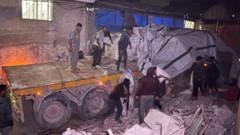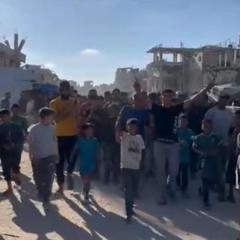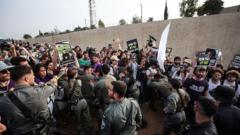The United Nations announced that over 90 truckloads of humanitarian aid were collected inside the Gaza Strip following a three-day delay caused by an 11-week blockade. The aid, which included essential items like flour, baby food, and medical supplies, was retrieved from the Kerem Shalom crossing and sent to distribution warehouses. Imagery showed local bakers utilizing some of the flour to produce much-needed bread.
Aid Distribution in Gaza: UN Collects Over 90 Lorries After Long Blockade Delays

Aid Distribution in Gaza: UN Collects Over 90 Lorries After Long Blockade Delays
The UN successfully gathered aid from Gaza, but experts warn it's far from enough to meet urgent needs in the region.
According to the UN, the delays were attributed to insecurity in the designated route cleared by the Israeli military for aid convoys. While Israeli authorities permitted an additional 100 lorries to pass through the crossing, UN officials stated that the amount still falls short of addressing the pressing humanitarian crisis. Reports indicate troubling conditions in Gaza, where 2.1 million residents experience significant food shortages, and many children are diagnosed with acute malnutrition. The Integrated Food Security Phase Classification (IPC), backed by the UN, warns that approximately half a million individuals might face starvation in the upcoming months.
On a recent night, the UN shared that they collected nearly 90 truckloads of supplies and dispatched them to the affected areas. Footage illustrated aid lorries traveling through southern Gaza, with visuals of flour sacks being unloaded for bread production.
Antoine Renard, a senior official from the World Food Programme (WFP), informed the BBC that the Israeli military's insistence on a perilous route for the lorries raised concerns for both the drivers and the population, potentially leading to violence from those in desperate need of food. The current commercial value of each truckload of flour is estimated around $400,000, highlighting the economic strain faced due to soaring prices.
The UN stressed the necessity for a considerable number of trucks—hundreds daily—to reach warehouses via a safer route, cautioning that insufficient aid leads to heightened anxiety and risk of conflict among locals. Given the volatile circumstances, aid agencies have refrained from using armed escorts, deeming it too dangerous.
Following a halt in aid deliveries on March 2, Israel resumed military operations after a two-week ceasefire with Hamas, utilizing the situation to apply pressure for the release of hostages held by the group. While Israel asserts that aid supplies are adequate and accuses Hamas of misappropriation of resources, the UN refutes claims of diverted aid, emphasizing that international humanitarian law mandates the provision of essential supplies to civilians in Gaza.
Israeli Prime Minister Benjamin Netanyahu stated recently that limited food shipments would facilitate ongoing military operations in Gaza, expressing the need to prevent a humanitarian crisis while maintaining operational freedom. However, a US-Israeli plan to deliver aid through private contractors has been criticized by humanitarian groups for potentially undermining essential humanitarian principles.
As violence escalates, with continuous bombardments and ground operations reported by the Hamas-run health ministry, the urgency for proper aid distribution remains critical. Current estimates indicate that about 81% of Gaza territory is under evacuation orders or designated as militarized zones, further complicating the humanitarian landscape where nearly 600,000 have been displaced since March.
The ongoing military campaign initiated in response to Hamas's attack on October 7 has led to tremendous casualties, with thousands dead and significant displacement in Gaza. As protests against Hamas persist and emergency situations worsen, international observers call for sustained attention to the dire humanitarian crisis unfolding in the region.
On a recent night, the UN shared that they collected nearly 90 truckloads of supplies and dispatched them to the affected areas. Footage illustrated aid lorries traveling through southern Gaza, with visuals of flour sacks being unloaded for bread production.
Antoine Renard, a senior official from the World Food Programme (WFP), informed the BBC that the Israeli military's insistence on a perilous route for the lorries raised concerns for both the drivers and the population, potentially leading to violence from those in desperate need of food. The current commercial value of each truckload of flour is estimated around $400,000, highlighting the economic strain faced due to soaring prices.
The UN stressed the necessity for a considerable number of trucks—hundreds daily—to reach warehouses via a safer route, cautioning that insufficient aid leads to heightened anxiety and risk of conflict among locals. Given the volatile circumstances, aid agencies have refrained from using armed escorts, deeming it too dangerous.
Following a halt in aid deliveries on March 2, Israel resumed military operations after a two-week ceasefire with Hamas, utilizing the situation to apply pressure for the release of hostages held by the group. While Israel asserts that aid supplies are adequate and accuses Hamas of misappropriation of resources, the UN refutes claims of diverted aid, emphasizing that international humanitarian law mandates the provision of essential supplies to civilians in Gaza.
Israeli Prime Minister Benjamin Netanyahu stated recently that limited food shipments would facilitate ongoing military operations in Gaza, expressing the need to prevent a humanitarian crisis while maintaining operational freedom. However, a US-Israeli plan to deliver aid through private contractors has been criticized by humanitarian groups for potentially undermining essential humanitarian principles.
As violence escalates, with continuous bombardments and ground operations reported by the Hamas-run health ministry, the urgency for proper aid distribution remains critical. Current estimates indicate that about 81% of Gaza territory is under evacuation orders or designated as militarized zones, further complicating the humanitarian landscape where nearly 600,000 have been displaced since March.
The ongoing military campaign initiated in response to Hamas's attack on October 7 has led to tremendous casualties, with thousands dead and significant displacement in Gaza. As protests against Hamas persist and emergency situations worsen, international observers call for sustained attention to the dire humanitarian crisis unfolding in the region.




















